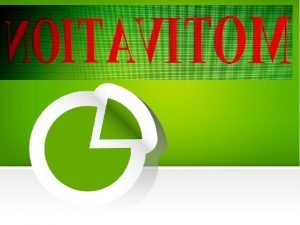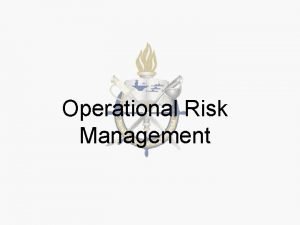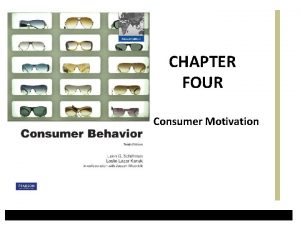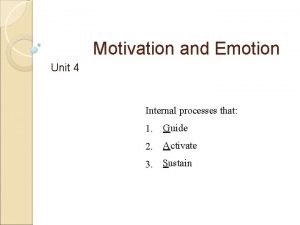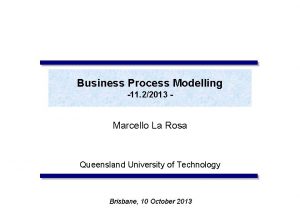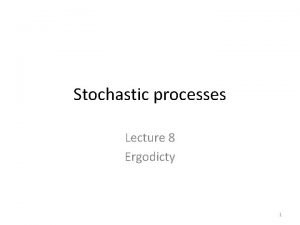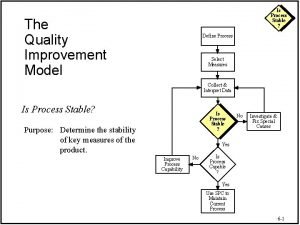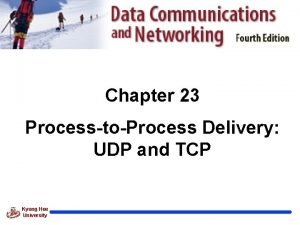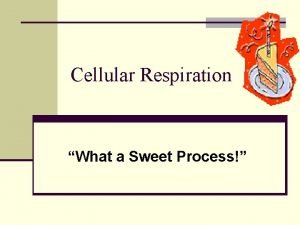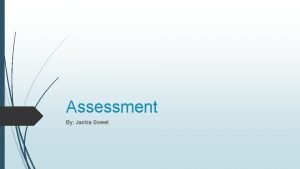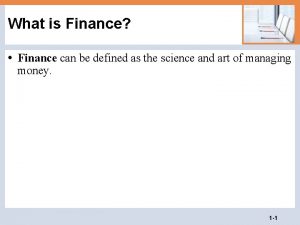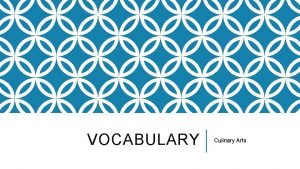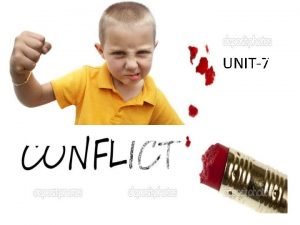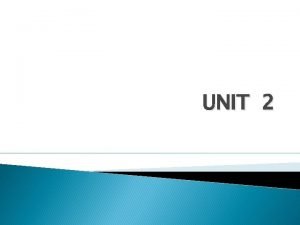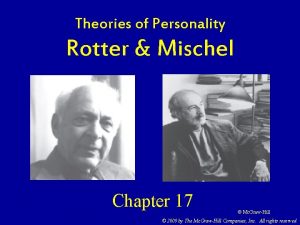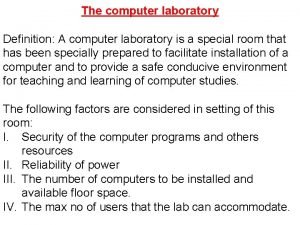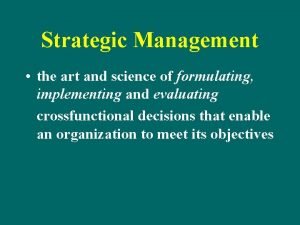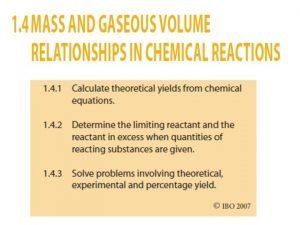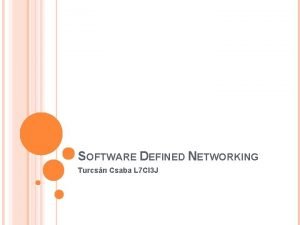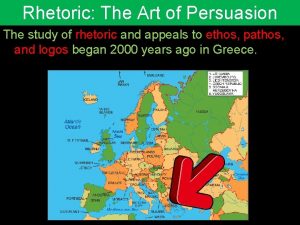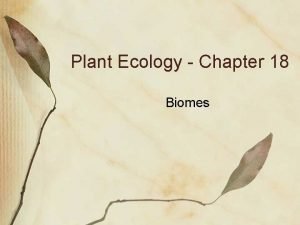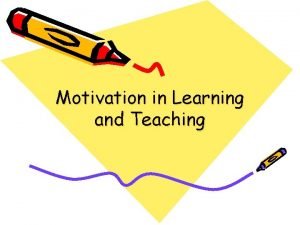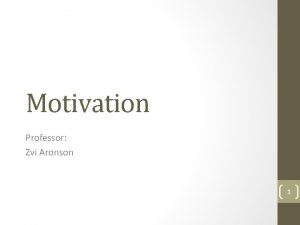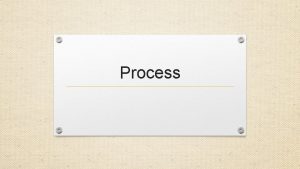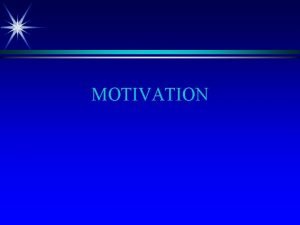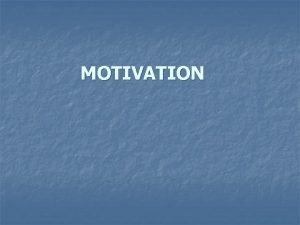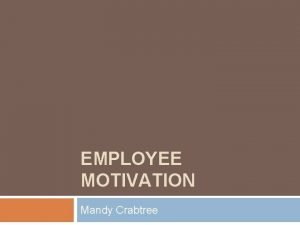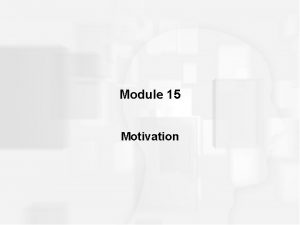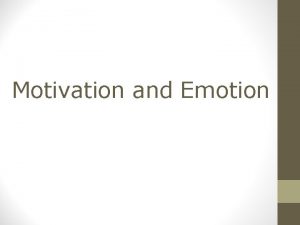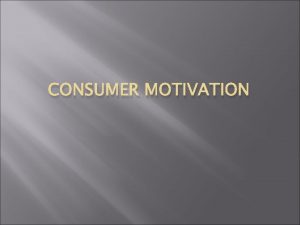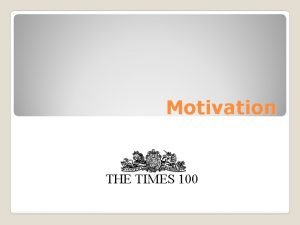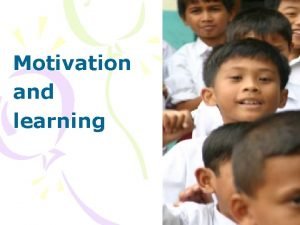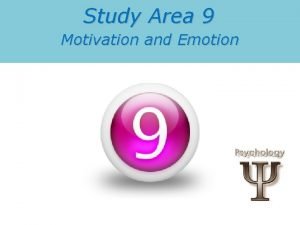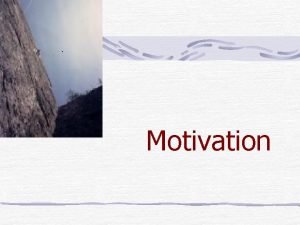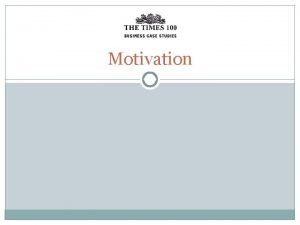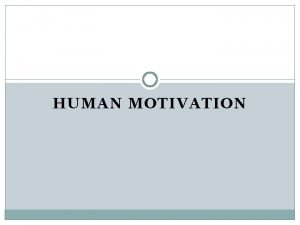MOTIVATION Motivation is defined as the process that




















































































- Slides: 84

MOTIVATION

• Motivation is defined as the process that initiates, guides, and maintains goal-oriented behaviors. Motivation is what causes us to act, whether it is getting a glass of water to reduce thirst or reading a book to gain knowledge. • Motivation is defined as the desire and action towards goal-directed behavior.

• Motivation is defined as the desire to achieve a goal or a certain performance level, leading to goal-directed behavior. When we refer to someone as being motivated, we mean that the person is trying hard to accomplish a certain task. Motivation is clearly important if someone is to perform well; however, it is not sufficient.

• Motivation involves the biological, emotional, social and cognitive forces that activate behavior. In everyday usage, the term motivation is frequently used to describe why a person does something. • Motivation is the driving force which help causes us to achieve goals. • Motivation can be defined as the needs, desires, feelings and ideas that direct our behavior toward a goal. These needs, desires, feelings and ideas can be simple to understand, like drinking water to end thirst,

• The term motivation refers to factors that activate, direct, and sustain goal-directed behavior. . . Motives are the "whys" of behavior - the needs or wants that drive behavior and explain what we do. We don't actually observe a motive; rather, we infer that one exists based on the behavior we observe. " (Nevid, 2013)

• Motivation describes the wants or needs that direct behavior toward a goal. It is an urge to behave or act in a way that will satisfy certain conditions, such as wishes, desires, or goals. • Motivation can be defined as a reason (or reasons) which leads an individual to act in a certain way. Motivation is the force that causes an individual to take action and initiate, guide and maintain behaviors. There can be variety of different forces at play behind the cause of motivation.

Drives and Motives • Motivations are commonly separated into drives and motives. Drives are primarily biological, like thirst, hunger, sleepiness, and the need to reproduce—all of which lead us to seek out and take part in certain activities. Drives are believed to originate within a person and may not require external stimuli to encourage behavior. Motives, on the other hand, are primarily driven by social and psychological mechanisms, such as work, family, and relationships. They include factors like praise and approval.

• Both drives and motives can be manipulated by stimulation and deprivation. Motivation can be stimulated by uncomfortable or aversive conditions or events (shocks, loud noise, or excessive heat or cold can motivate us to seek better conditions) or by attractions to positive or pleasurable conditions or events (such as food or sex). We also become motivated when we're deprived of something that we want or need, like adequate nutrition or social contact.

Motivational Cycle • The state of motivation is further comprised of four different states, which takes place in an organism to drive him towards each action. Each action is first initiated because of a particular need. The need drives the person into taking actions. Positive results, caused due to the actions, further acts as an incentive motivating a person towards the goal.

• But the individual can never stop after achieving a certain goal, and this phenomenon continues on and on. This phenomenon has been termed as Motivational Cycle.


Need • A need is lack or deficit of some necessity. It’s a state of physical deprivation that causes tension within an organism. The tension caused when the organism is deprived of basic necessities of life as food, water, and sleep, causes the internal environment of an organism to be imbalanced. The imbalance caused by the need arouses the organism to maintain its balance. For any goal directed behavior, need is the first condition or stimulating factor.

Drive • Need leads to drive, which is the second step towards achieving goal. Drive can be defined as the state of tension or arousal produced by need. The drive can also be considered as the original source of energy that activates an organism. For instance, when an organism is hungry and/or thirsty, the organism seeks to reduce this drive by eating and/or drinking.

• Drive acts as a strong persistent stimulus to push an organism towards its goal. It is the state of heightened tension leading to restless activity and preparatory behavior.

Incentive • The object of the environment that activates, directs, and maintains behavior is called incentive. It can be anything as long as it has either positive or negative value in motivating behavior. • The incentive theory rests on the assumption that the behaving organism is well aware of his actions and the consequences received as a result.

• The theory also understands incentives as the motivation, which a person has to achieve any particular goal object. The motivated behavior is directed towards incentive and getting closer to the incentive provides satisfaction of the aroused drive.

• For example: behavior like eating food is an incentive that reduces the drive of the person caused by the need to fulfill his hunger. The reduction of behavior then cuts off and restores balance in an organism. • The incentive is something in the external environment that satisfies the need and thus reduces the drive through consummative activity.

Goal • The reduction of tension in the body can be considered as the goal of any motivated behavior. Let’s go back to the example of a hungry man. A hungry man eats food, and his body restores to a balanced condition. This then reduces the tension. This reduction of tension as a result of an energized activity is called goal. Once the goal has been completed, the organism is again ready for another goalmotivated behavior.

• Goals might be both positive or negative. Positive goals are the ones that an organism tries to attain, such as sexual companionship, food, victory etc. negative goals are the ones that an organism tries to escape from or avoid, such as embarrassing situations, punishments. • These four steps continue on and on throughout the life-course of an organism. Because the needs are never ending, it leads to drive, which then lead to incentive and the goal.

• For Example: The motivational cycle of the hungry man is over once when he eats and the goal is satisfied. But, the cycle will restart once the man gets hungry again. The cycle goes on and on only to end at the demise of an organism, at which point, the needs permanently stop. Motivational cycle means that behavior goes on in a sequence. Often times, a single motivated behavior can also fulfill multiple needs.

TYPES OF MOTIVATION • INTRINSIC MOTIVATION • The act of being motivated by internal factors to perform certain actions and behavior is called intrinsic motivation. In other words, intrinsic motivation means doing something just because you want to. There is neither pressure nor any sort of reward for your actions, but you still do them because you want to or you believe it’s the right thing to do.

• Intrinsic motivation can also be termed as the stimulation that drives an individual to bring about change or perform certain behavior for his or her own internal satisfaction or pleasure.

The needs or causes that lead to intrinsic motivation are: • Autonomy: the need to have complete control over one’s own life. • Relatedness: the need to maintain companionship or connection with others. • Competence: the need to do be the best and/or succeed.

• Intrinsic and Extrinsic motivation are completely in contrast with each other in the manner they work. In short, intrinsic motivation refers to getting motivated from the inside or self-motivation. On the other hand, extrinsic motivation refers to the motivation caused because of exterior factors.

EXTRINSIC MOTIVATION • Whenever an individual performs an action or behavior because the individual is affected by the eternal factors such as rewards or punishments, such form of motivation is called extrinsic motivation. Whenever a person is motivated by external factors, whether to avoid negative consequences or to achieve positive outcomes, it is wholly considered to be extrinsic motivation.

• There can be numerous causes of extrinsic motivation. Some of the most common needs (external factors) that lead a person to do certain things are • Money • Praise • Competition • Threat of a punishment

• Extrinsic incentives can be used to motivate a whole group, thus increasing productivity in workplace or creating a better learning environment in classrooms. • Extrinsic incentives lead to individual benefits. These motivations can lead to behavior, which would have never been possible otherwise. Example: A student might never feel the intrinsic motivation to study, but external factors like medals or other forms of prize might motivate the student to study harder.


• • • Instinct Theory Drive Reduction Theory Arousal Theory Incentive Theory Maslow’s Hierarchy of Needs.

Instinct Theory of Motivation or Evolutionary Theory of Motivation • Instinct theory of motivation suggests that the key to our motivation is biological or genetic programming of our body. The general idea is that similar motivations occur on humans because of the similar biological programming shared by humans. As we act or behave on other motivations emerged as a result of our core motivation, all our actions are considered as instincts. A popular example is seasonal migration of birds due south in winter. • William James (1842– 1910) was an important contributor to early research into motivation, and he theorized that behavior was driven by a number of instincts that aid survival.

• Every organism is born with different biological traits and tendencies in order to help them survive. These aren’t learned or experienced behaviors, rather patterns of behavior that occur naturally and are goaldirected. These patterns of behavior are referred to as instincts, and theory suggests that instincts drive all behaviors.

• According to instinct theories, people are motivated to behave in certain ways because they are evolutionarily programmed to do so. • William James created a list of human instincts that included such things as attachment, play, shame, anger, fear, shyness, modesty, and love. The main problem with this theory is that it did not really explain behavior, it just described it.

• Instinct theory is derived from our biological make-up.

Drive Reduction Theory • The theory suggests that we do what we do in order to reduce the internal tension caused by our unfulfilled needs. For instance, we drink water when we feel the internal tension inside our body caused by thirsty. • After being proposed in 1943 by Clark Hull, it was quite popular till late 50 s. • According to drive-reduction theory, humans are motivated to satisfy physiological needs in order to maintain homeostasis.

• The Drive Reduction Theory is another early motivation theory that states that we behave to satisfy needs. These needs are called drives, and they can be primary drives, such as food, water, and sex, or secondary drives, which are learned needs like money, social approval, and power.

• According to Hull, physiological needs result in psychological drive states that direct behavior to meet the needs and, ultimately, bring the system back to homeostasis. • Primary drives are innate biological needs (e. g. , thirst, hunger, and desire for sex), whereas secondary drives are associated with—and indirectly satisfy—primary drives (e. g. , the desire for money, which helps pay for food and shelter). • Drives are thought to underlie all behavior in that behaviors are only conditioned, or learned, if they satisfy a drive.

• Drive-reduction theory has been criticized for failing to explain how secondary reinforcers reduce drive or why individuals engage in “pleasure-seeking” behaviors. • According to the drive theory of motivation, people are motivated to take certain actions in order to reduce the internal tension that is caused by unmet needs. For example, you might be motivated to drink a glass of water in order to reduce the internal state of thirst.

• According to this theory, deviations from homeostasis create physiological needs. These needs result in psychological drive states that direct behavior to meet the need and, ultimately, bring the system back to homeostasis. When a physiological need is not satisfied, a negative state of tension is created; when the need is satisfied, the drive to satisfy that need is reduced and the organism returns to homeostasis. In this way, a drive can be thought of as an instinctual need that has the power to motivate behavior.

• For example, if it’s been a while since you ate, your blood sugar levels will drop below normal. Low blood sugar induces a physiological need and a corresponding drive state (i. e. , hunger) that will direct you to seek out and consume food. Eating will eliminate the hunger, and, ultimately, your blood sugar levels will return to normal.

• Drive-reduction theory distinguishes between primary and secondary drives. Primary drives are innate biological needs (e. g. , thirst, hunger, and desire for sex) that are usually necessary for survival. Secondary drives, on the other hand, are not usually necessary for survival and are often linked to social or identity factors (e. g. , the desire for wealth). Secondary drives are associated with primary drives because the satisfaction of secondary drives indirectly satisfies primary drives.

• For example, the desire for wealth is not necessary for survival; however, wealth provides you with money that can be used to acquire food, shelter, and other basic needs, thereby indirectly satisfying these primary drives. Secondary drives become associated with primary drives through classical conditioning.

• This theory is useful in explaining behaviors that have a strong biological component, such as hunger or thirst. The problem with the drive theory of motivation is that these behaviors are not always motivated purely by physiological needs. For example, people often eat even when they are not really hungry.

• According to this theory, when we have a drive, our bodies get in a state of tension or arousal that we must reduce to return to a state of balance, thus the name Drive Reduction Theory. This state of biological balance is called homeostasis. When we address our drives, we are always trying to maintain the homeostasis.

• So for example, if you feel thirst, your body loses its balance and feels tension because it needs liquid, and then this drive motivates you to drink water. When you drink the necessary amount of water, your body returns to the state of homeostasis.

Arousal Theory of Motivation • Arousal theory expands upon drive-reduction theory by considering levels of arousal as potential motivators. • The arousal theory of motivation suggests that people take certain actions to either decrease or increase levels of arousal. • When arousal levels get too low, for example, a person might watch an exciting movie or go for a jog. When arousal levels get too high, on the other hand, a person would probably look for ways to relax such as meditating or reading a book.

• According to this theory, we are motivated to maintain an optimal level of arousal, although this level can vary based on the individual or the situation. • While drive -reduction theory focuses primarily on biological needs as motivators, arousal theory examines the influence of the neurotransmitter dopamine as a motivator in the body.

• Arousal theory proposes that motivation is strongly linked to biological factors that control reward sensitivity and goal-driven behavior. • The reward system in the human body spurs physiological arousal, which motivates individuals to engage in whatever behavior is necessary to relieve their arousal.

• Arousal theory states that we are driven to maintain a certain level of arousal in order to feel comfortable. Arousal refers to a state of emotional, intellectual, and physical activity. It is different from the above theory, however, because it doesn’t rely on only a reduction of tension, but a balanced amount. It also does better to explain why people climb mountains, go to school, or watch sad movies.

Incentive Theory: The External Rewards • To explain more complex behaviors, psychologists developed the Incentive Theory. Incentives are external stimuli that motivate our behavior because we learn to associate some stimuli with rewards and others with punishments. We are then motivated to seek rewards and behave in that way.

• this theory is all about external stimuli, not internal ones like the Drive Reduction Theory or the Arousal Theory. • According to incentive theory, behavior is primarily motivated by the incentive of extrinsic factors. • Motivations are commonly separated into two different types based on the nature of the motivator: intrinsic (arising from internal factors) or extrinsic (arising from external factors).

• Incentive theory argues that behavior is primarily extrinsically motivated: people are motivated to perform activities if they receive a reward afterward, rather than simply because they enjoy the activities themselves. • Intrinsically motivated behaviors are performed because of the sense of personal satisfaction that they bring. • Extrinsically motivated behaviors are performed in order to receive something from others—such as a promotion, praise, candy, money, or attention.

• The theory of motivation that suggests that the behavior is motivated because of reinforcement or incentives is referred to as Incentive Theory of Motivation. It suggests that our actions are influenced by outside incentives, and we are attracted to the incentives rather than having the desire to reduce stimulus.

• The theory is quite similar to Operant Conditioning, as rewards drive our actions. The only difference is that we know about the rewards and we intentionally perform actions in order to receive rewards. So in that sense, greater the rewards – higher the rate of actions to pursue reinforcements.

Maslow – hierarchy of needs or Humanistic Theory • This theory of motivation suggests that our cognitive processes are also one of the factors that affect our actions. Abraham Maslow’s Hierarchy of Needs is one famous humanistic theory of motivation, which presents motivations at different levels. • the hierarchy of needs states that human beings have a series of needs that must be satisfied in a predetermined order.

• Maslow’s hierarchy of needs defines motivation as the process of satisfying certain needs that are required for long-term survival and development. • There are some needs that are basic to all human beings, and in their absence, nothing else matters. As we satisfy these basic needs, they no longer serve as motivators and we begin to satisfy higher-order needs. • Maslow divided human needs into a pyramid that includes physiological, safety, love/belonging, esteem, and self-actualization needs. Higherorder needs can only be pursued when the lower needs are met.

• Maslow’s theory defines motivation as the process of satisfying certain needs that are required for long-term development. According to Maslow, a need is a relatively lasting condition or feeling that requires relief or satisfaction, and it tends to influence action over the long term. Some needs (like hunger) may decrease when satisfied, while others (like curiosity) may not.

• There are some needs that are basic to all human beings, and in their absence nothing else matters. As we satisfy these basic needs, we start looking to satisfy higher order needs. • The most basic of Maslow’s needs are physiological needs. Physiological needs refer to the need for food, water, and other biological needs. These needs are basic because when they are lacking, the search for them may overpower all other urges.


1. Physiological needs (e. g. food, water, shelter, sleep) • It includes the most basic needs for humans to survive, such as air, water and food. Maslow emphasized, our body and mind cannot function well if these requirements are not fulfilled. • These physiological needs are the most dominant of all needs. So if someone is missing everything in his/her life, probably the major motivation would be to fulfil his/her physiological needs rather than any others. A person who is lacking food, safety, love (also sex) and esteem, would most probably hunger food (and also for money, salary to buy food) than for anything else.

• The most basic of Maslow’s needs are physiological needs, such as the need for air, food, and water. When you are very hungry, for example, all your behavior may be motivated by the need to find food. Once you eat, the search for food ceases, and the need for food no longer motivates you.

Safety and security (secure source of income, a place to live, health and well-being) • Once physiological needs are satisfied, people tend to become concerned about safety needs. Are they safe from danger, pain, or an uncertain future? At this stage they will be motivated to direct their behavior toward obtaining shelter and protection in order to satisfy this need. • If the physiological needs are relatively well contented, new needs will appear, the so called safety needs. Safety needs refer to a person’s desire for security or protection. Basically everything looks less important than safety and protection (the physiological needs even sometimes).

• The peaceful, sure, safety and unwavering society makes us feel in safety enough from criminal assaults, murder, unbelievable natural catastrophes, and so on. In that case people no longer have any safety needs as first-line motivators.

• Meeting with safety needs demonstrated as a preference for insurance policies, saving accounts or job security, etc. , we think about the lack of economic safety. Children have a greater need to feel safe. That is the reason why this level is more important for children. • Safety and security needs include: Personal security; Financial security; Health and well-being; Safety mesh against accidents, illnesses and their adverse impacts. • To tell the truth, in real dangers and traumas – like war, murder, natural catastrophes, criminal assault, etc. -, the needs for safety become an active, first-line and dominant mobilizer of human beings.

Belongingness and love (integration into social groups, feel part of a community or a group; affectionate relationships) • If both the physiological and the safety needs are fulfilled, the affection, love and belongingness needs come into prominence. Maslow claimed people need to belong and accepted among their social groups. Love needs involve giving and receiving affections (love is not synonymous with sex – sex is a physiological need). When they are unsatisfied, a person will immediately eliminate the lack of friends, peers and partner. Many people suffer from social nervousness, loneliness, social isolation and also clinical depression because of the lack of this love or belongingness factor.

• Once safety needs have been met, social needs for love/belonging become important. This can include the need to bond with other human beings, the need to be loved, and the need to form lasting attachments. Having no attachments can negatively affect health and well-being; as a result, people are motivated to find friends and romantic partners.


4. Esteem (respect for a person as a useful, honourable human being) • In our society most people long for a stable and high valuation of themselves, for the esteem of others and for self-respect or self-esteem. • Esteem means being valued, respected and appreciated by others. Humans need to feel to be valued, such as being useful and necessary in the world. People with low self-esteem often need respect from others. Maslow divided two types of esteem needs: a ‘lower’ version and a ‘higher’ version.

• Once love and belonging needs have been satisfied, esteem needs become more salient. Esteem needs refer to the desire to be respected by one’s peers, to feel important, and to be appreciated. People will often look for ways to achieve a sense of mastery, and they may seek validation and praise from others in order to fulfill these needs.

• The ‘lower’ version of esteem is the need for respect from others: for example attention, prestige, status and loving their opinion. The ‘higher’ version is the need for self-respect: for example, the person may need independence, and freedom or self-confidence. The most stable and therefore the healthiest self-esteem is based on respect from others. External fame or celebrity and unwarranted adulation won’t cause self-esteem, although you feel better for a while.

Self-actualization (individual’s desire to grow and develop to his or her fullest potential) • Self-actualization reflects an individual’s desire to grow and develop to his/her fullest potential. People like opportunities, choosing his/her own versions, challenging positions or creative tasks. Maslow described this level as the ‘need to accomplish everything that one can, to become the most that one can be’. Maslow believed that people must overcome their other needs – described above -, not only achieve them. At this level, individual differences are the largest. •

• As each level is adequately satisfied, we are then motivated to satisfy the next level in the hierarchy, always new and higher needs are coming. This is what we mean, when the basic human needs are drawn like a pyramid, a hierarchy. Life experiences, including divorce and loss of job, may cause an individual to fluctuate between levels of the hierarchy. These five different levels were further sub-categorised into two main groups: deficiency and growth needs.












• What Is Self-Esteem? • In psychology, the term self-esteem is used to describe a person's overall sense of self-worth or personal value. In other words, how much you appreciate and like yourself. • Self-esteem is often seen as a personality trait, which means that it tends to be stable and enduring. • Self-esteem can involve a variety of beliefs about yourself, such as the appraisal of your own appearance, beliefs, emotions, and behaviors.

• https: //books. google. co. in/books? id=pm. N wq. I 0 YQOYC&pg=PA 65&lpg=PA 65&dq=re storation+of+muscle+phosphagen+stores &source=bl&ots=V 4 SYU 6 Bdr. E&sig=7 lmf 5 w 8 dksewc 1 Ya. ONYsbk 5 KJR 0&hl=en&sa= X&ei=w 33 d. VNiy. FJe. Ku. ASBh 4 GYDQ&sqi= 2&ved=0 CCk. Q 6 AEw. AQ#v=onepage&q=r estoration%20 of%20 muscle%20 phosphag en%20 stores&f=false
 Ngoại tâm thu thất chùm đôi
Ngoại tâm thu thất chùm đôi Block av độ 1
Block av độ 1 Thể thơ truyền thống
Thể thơ truyền thống Thơ thất ngôn tứ tuyệt đường luật
Thơ thất ngôn tứ tuyệt đường luật Chiến lược kinh doanh quốc tế của walmart
Chiến lược kinh doanh quốc tế của walmart Tìm vết của mặt phẳng
Tìm vết của mặt phẳng Hãy nói thật ít để làm được nhiều
Hãy nói thật ít để làm được nhiều Tôn thất thuyết là ai
Tôn thất thuyết là ai Gây tê cơ vuông thắt lưng
Gây tê cơ vuông thắt lưng Sau thất bại ở hồ điển triệt
Sau thất bại ở hồ điển triệt Is a collection of well defined objects
Is a collection of well defined objects Motivation is defined as:
Motivation is defined as: It is defined as outsourcing process that can be enabled by
It is defined as outsourcing process that can be enabled by What is the definition of time critical risk management
What is the definition of time critical risk management Hình ảnh bộ gõ cơ thể búng tay
Hình ảnh bộ gõ cơ thể búng tay Lp html
Lp html Bổ thể
Bổ thể Tỉ lệ cơ thể trẻ em
Tỉ lệ cơ thể trẻ em Voi kéo gỗ như thế nào
Voi kéo gỗ như thế nào Tư thế worms-breton
Tư thế worms-breton Hát lên người ơi
Hát lên người ơi Các môn thể thao bắt đầu bằng tiếng chạy
Các môn thể thao bắt đầu bằng tiếng chạy Thế nào là hệ số cao nhất
Thế nào là hệ số cao nhất Các châu lục và đại dương trên thế giới
Các châu lục và đại dương trên thế giới Công thức tiính động năng
Công thức tiính động năng Trời xanh đây là của chúng ta thể thơ
Trời xanh đây là của chúng ta thể thơ Mật thư anh em như thể tay chân
Mật thư anh em như thể tay chân Phép trừ bù
Phép trừ bù Phản ứng thế ankan
Phản ứng thế ankan Các châu lục và đại dương trên thế giới
Các châu lục và đại dương trên thế giới Quá trình desamine hóa có thể tạo ra
Quá trình desamine hóa có thể tạo ra Một số thể thơ truyền thống
Một số thể thơ truyền thống Cái miệng bé xinh thế chỉ nói điều hay thôi
Cái miệng bé xinh thế chỉ nói điều hay thôi Vẽ hình chiếu vuông góc của vật thể sau
Vẽ hình chiếu vuông góc của vật thể sau Thế nào là sự mỏi cơ
Thế nào là sự mỏi cơ đặc điểm cơ thể của người tối cổ
đặc điểm cơ thể của người tối cổ Thế nào là giọng cùng tên? *
Thế nào là giọng cùng tên? * Vẽ hình chiếu đứng bằng cạnh của vật thể
Vẽ hình chiếu đứng bằng cạnh của vật thể Tia chieu sa te
Tia chieu sa te Thẻ vin
Thẻ vin đại từ thay thế
đại từ thay thế điện thế nghỉ
điện thế nghỉ Tư thế ngồi viết
Tư thế ngồi viết Diễn thế sinh thái là
Diễn thế sinh thái là Dot
Dot Số nguyên tố là số gì
Số nguyên tố là số gì Tư thế ngồi viết
Tư thế ngồi viết Lời thề hippocrates
Lời thề hippocrates Thiếu nhi thế giới liên hoan
Thiếu nhi thế giới liên hoan ưu thế lai là gì
ưu thế lai là gì Hổ sinh sản vào mùa nào
Hổ sinh sản vào mùa nào Khi nào hổ mẹ dạy hổ con săn mồi
Khi nào hổ mẹ dạy hổ con săn mồi Sơ đồ cơ thể người
Sơ đồ cơ thể người Từ ngữ thể hiện lòng nhân hậu
Từ ngữ thể hiện lòng nhân hậu Thế nào là mạng điện lắp đặt kiểu nổi
Thế nào là mạng điện lắp đặt kiểu nổi Are the sought-after results of motivated behavior
Are the sought-after results of motivated behavior Motivation is an internal process
Motivation is an internal process Bones practical exam
Bones practical exam Substantive vs procedural due process
Substantive vs procedural due process Business process levels
Business process levels Properties of autocorrelation function
Properties of autocorrelation function What is process to process delivery
What is process to process delivery Condylar and coronoid process
Condylar and coronoid process Stable quality
Stable quality Process-to-process delivery
Process-to-process delivery Sweet process review
Sweet process review Summative and subjective assessment
Summative and subjective assessment Piecewise function examples
Piecewise function examples Work in physics
Work in physics What is finance
What is finance Rondelle definition cooking
Rondelle definition cooking Usability quality attribute that assesses
Usability quality attribute that assesses Conflict management
Conflict management Ambiguously defined triangle
Ambiguously defined triangle Learning can be defined as
Learning can be defined as Rotter defined maladaptive behavior as behavior that
Rotter defined maladaptive behavior as behavior that Computer
Computer The art and science of formulating
The art and science of formulating Stoichiometry is defined as the quantitative study of
Stoichiometry is defined as the quantitative study of Stoichiometry is defined as the quantitative study of
Stoichiometry is defined as the quantitative study of 7 ci
7 ci Sdn introduction
Sdn introduction Which greek philosopher defined the art of persuasion
Which greek philosopher defined the art of persuasion Sql user defined table
Sql user defined table Terrestrial biomes definition
Terrestrial biomes definition











